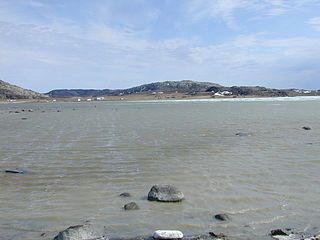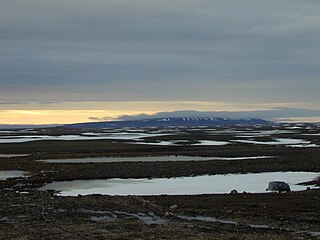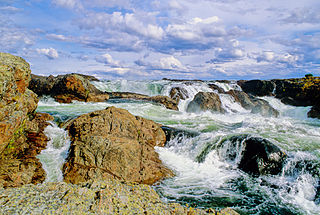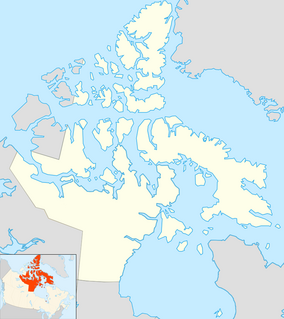
The Back River formerly Backs River is the 20th longest Canadian river and is located in the Northwest Territories and Nunavut. It rises at an unnamed lake in the North Slave Region of the Northwest Territories and flows more than 974 km (605 mi) mostly through the Kivalliq Region, Nunavut, to its mouth at the Arctic Ocean in the Kitikmeot Region of Nunavut.

Cambridge Bay is a hamlet located on Victoria Island in the Kitikmeot Region of Nunavut, Canada. It is the largest settlement on Victoria Island. Cambridge Bay is named for Prince Adolphus, Duke of Cambridge, while the traditional Inuinnaqtun name for the area is Ikaluktutiak or Iqaluktuttiaq meaning "good fishing place".

Umingmaktok is a now abandoned settlement located in Bathurst Inlet in the Kitikmeot Region of the Canadian territory of Nunavut. The community was previously known as Bay Chimo and the Inuit refer to the community as Umingmaktuuq.

Bathurst Inlet,, is a small Inuit community located in Bathurst Inlet in the Kitikmeot Region of Nunavut, Canada. As of the 2016 census the population remained at zero.

Ovayok Territorial Park is a park situated 15 km (9.3 mi) east of Cambridge Bay, in the Kitikmeot Region, Nunavut, Canada. The park is relatively small and covers an area of approximately 16 km2 (6.2 sq mi). The park can be accessed by vehicle from the community as a gravel road runs directly to it.

The Kazan River, is a Canadian Heritage River located in Nunavut, Canada. The Dene name for the river was Kasba-tue meaning "white partridge river." The name was apparently changed to Kazan in the late 19th century due to the influence of Order of Mary Immaculate missionaries. The river headwaters are in northern Saskatchewan at Kasba Lake, and it flows north for about 1000 km (621 mi) before emptying into Baker Lake, on the opposite side of the mouth of the Thelon River. Along its course the river flows through several lakes, including Ennadai Lake and Yathkyed Lake, over the Kazan Falls, down a red sandstone gorge and through both boreal forest and tundra. It is the last section of the river, below Ennadai Lake, that is above the timber line and is designated a Canadian Heritage River.

The Peary caribou is a subspecies of caribou found in the High Arctic islands of Nunavut and the Northwest Territories in Canada. They are the smallest of the North American caribou, with the females weighing an average of 60 kg (130 lb) and the males 110 kg (240 lb). In length the females average 1.4 m and the males 1.7 m.

The barren-ground caribou is a subspecies of the reindeer that is found mainly in the Canadian territories of Nunavut and the Northwest Territories, as well as in Kitaa, Greenland. It sometimes includes the similar-looking Porcupine caribou, in which case the barren-ground caribou is also found in Alaska. The barren-ground caribou is a medium-sized caribou, smaller and lighter-coloured than the boreal woodland caribou, with the females weighing around 90 kg (200 lb) and the males around 150 kg (330 lb). However, on some of the smaller islands, the average weight may be less. The large migratory herds of barren-ground caribou take their names from the traditional calving grounds, such as the Ahiak herd, the Baffin Island herds, the Bathurst herd, the Beverly herd, the Bluenose East herd, the Bluenose West herd, the Porcupine herd and the Qamanirjuaq herd.
The Burnside River is a river in the Canadian territory of Nunavut. It has its headwaters at Contwoyto Lake, flows across the Precambrian Shield's Contwoyto Plateau, flows through isolated and rugged tundra, into Lake Kathawachaga, and through the Wilberforce Hills region. Before emptying into Bathurst Inlet on the Arctic Ocean, the Mara River empties into the Burnside River. The river has an island, Nadlak, historically notable for Inuit use of caribou antlers as hut roof infrastructures.

Amadjuak Lake is a lake in the Qikiqtaaluk Region, Nunavut, Canada. Along with Nettilling Lake, it is located in south-central Baffin Island's Great Plain of the Koukdjuak. It is 154 km (96 mi) south of Burwash Bay. The closest community is Iqaluit.

The Thelon Wildlife Sanctuary, at 52,000 square kilometres (20,077 sq mi), over twice the area of Belgium, is the largest wildlife refuge in Canada. It is located in northern Canada's Arctic region, north of the tree line, straddling the Northwest Territories and Nunavut, halfway between Baker Lake and Yellowknife, and bordered on the north between the Baillie River on the west and the Consul River at the east by the Back River. It is the namesake of the Thelon River, whose river valley is resplendent with boreal forest biological diversity, hence its identification as a "Biological Site of Universal Importance" by the International Biological Program (IBP) in the 1960s.
Beverly Lake is a lake in the Kivalliq Region, Nunavut, Canada. It is located north of the Arctic tree line about 150 km (93 mi) northwest of Baker Lake, Nunavut. The western half of the lake is within Thelon Wildlife Sanctuary. The Thelon River, at the confluence with the Dubawnt River, empties into the lake's southwestern bank. The Kazan River empties into the Thelon River at Beverly Lake's southeastern bank, between Beverly and Aberdeen Lakes. A delta occurs on the Beverly Lake's southern edge, which includes the Isarurjuaq Peninsula.

Tahiryuaq, formerly Ferguson Lake, is located on southern Victoria Island in the Kitikmeot Region of Nunavut, in northern Canada. It drains westward into Iqaluktuuq which is a segment of the Ekalluk River, 5 mi (8.0 km) from the northeastern side of Wellington Bay (Ekaloktok), on Dease Strait, Arctic Ocean Ferguson Lake was the namesake of Constable Ferguson, a Royal Canadian Mounted Police member, but is now known by the original name of Tahiryuaq
Ferguson Lake is a lake in Kivalliq Region, Nunavut, Canada. It is located 150 km (93 mi) north of the tree line, midway between Yathkyed Lake and Qamanirjuaq Lake. The lake's outflow is to the east into the Ferguson River, which flows eastward through several lakes, emptying into northwestern Hudson Bay between Rankin Inlet and Whale Cove. The closest community is Baker Lake, 160 km (99 mi) to the north.
The Ferguson River originates on the eastern bank of Ferguson Lake within the northern Hearne Domain, Western Churchill province of the Churchill craton, the northwest section of the Canadian Shield in Nunavut's Kivalliq Region.

Copper Inuit are a Canadian Inuit group who live north of the tree line, in what is now Nunavut's Kitikmeot Region and the Northwest Territories's Inuvik Region. Most historically lived in the area around Coronation Gulf, on Victoria Island, and southern Banks Island.

The Umingmuktogmiut are a geographically defined Copper Inuit band in the northern Canadian territory of Nunavut, Kitikmeot Region. They were located on the western coast of Kiillinnguyaq, and also further south in eastern Bathurst Inlet around Everitt Point by the Barry Islands. Umingmuktogmiut were notable amongst other Copper Inuit as they had a permanent community, Umingmuktog. They could hunt and fish for Arctic char, Arctic fox, barren-ground caribou, fur seals, and muskox prevalent in the area.
The Copperneedle River originates within the northern Hearne Domain, Western Churchill province of the Churchill craton, the northwest section of the Canadian Shield in Nunavut's Kivalliq Region. There are rapids along the river, approximately 15 km (9.3 mi) from Hudson Bay's Dawson Inlet.
The Nanook River is located on Victoria Island in Northern Canada, commencing in the Northwest Territories and ending in Nunavut.
Caribou herds in Canada are discrete populations of the four subspecies, Rangifer tarandus—Barren ground, Woodland, Grant's, and Peary, —and their ecotypes, that are represented in Canada. Caribou herds can be found from the High Arctic region south to the boreal forest and Rocky Mountains and from the east to the west coasts.













